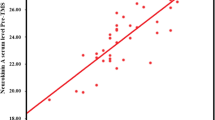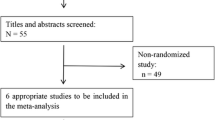Abstract
Background
Headache is one of the most common conditions troubling nearly 45% of the world’s population. Migraine headache itself, being more common among women, affects 7–18% of people. As much as 20–30% of the population report accompanying aura and neurological symptoms. In many cases, migraine headache can be effectively treated with suitably selected pharmacotherapies which include drugs used in symptomatic treatment. Frequent occurrence of the condition is treated with prophylaxis, which often fails. Neuromodulating methods are part of the multidirectional treatment and they may be valuable complement to pharmacotherapy.
Methods
Our study evaluates the impact of the transcranial direct current stimulation (tDCS) on the consumption of drugs and on pain conditions (frequency, duration, intensity). We recruited 50 patients with migraine headache (30 with aura, 20 without aura) refractory to pharmacological therapy. In 30 patients (18 with aura, 12 without aura) previous unsatisfactory treatment was supplemented with tDCS performed tenfold. 20 patients (12 with aura, 8 without aura) from a control group were treated with pharmacological methods The observation continued for 30 days after the stimulation.
Results
After tDCS, a reduction in the consumption of analgesics and triptans was reported. Additionally, we monitored pain intensity decrease during pain episodes, duration of episodes and the number of pain days. The subjective assessment of pain reduction in migraine patients encompassed 36–40% after tDCS much more effective in comparison to group with only pharmacotherapy (10–12.5%).
Conclusions
The study suggests that tDCS may be safe and useful clinical tool in migraine prophylaxis and treatment.
Similar content being viewed by others
References
Buse DC, Manack AN, Fanning KM, Serrano D, Reed ML, Turkel CC, et al. Chronic migraine prevalence, disability, and socio demographic factors: results from the American Migraine Prevalence and Prevention Study. Headache 2012;52 (10):1456–70.
Gallagher RM, Kunkel R. Migraine medication attributes important for patient compliance: concerns about side effects may delay treatment. Headache 2003;43(1):36–43.
Goadsby PJ, Sprenger T. Current practice and future directions in the prevention and acute management of migraine. Lancet Neurol 2010;9:285–98.
Dasilva AF, Mendonca ME, Zaghi S, Lopes M, Dossantos MF, Spierings EL, et al. tDCS-induced analgesia and electrical fields in pain-related neural networks in chronic migraine. Headache 2012;52(8):1283–95.
Viganò A, D’Elia TS, Sava SL, Auvé M, De Pasqua V, Colosimo A, et al. Transcranial Direct Current Stimulation (tDCS) of the visual cortex: a proof-of-concept study based on interictal electrophysiological abnormalities in migraine. J Headache Pain 2013;14:23.
Jürgens T. Neuromodulation in primary headaches. Pain Clin Updates Int Assoc Study Pain (IASP) 2012;20(5):1–7.
Antal A, Ambrus GG, Chaieb L. Toward unraveling reading-related modulations of tDCS-induced neuroplasticity in the human visual cortex. Front Psychol 2014;5:642.
Antal A, Kriener N, Lang N, Boros K, Paulus W. Cathodal transcranial direct current stimulation of the visual cortex in the prophylactic treatment of migraine. Cephalalgia 2011;31:820–8.
Shirahige L, Melo L, Nogueira F, Rocha S, Monte-Silva K. Efficacy of noninvasive brain stimulation on pain control in migraine patients: a systematic review and meta-analysis. Headache 2016;56(10):1565–96.
Headache Classification Committee of the International Headache Society. The International Classification of Headache Disorders. 3rd edition International Headache Society; 2013 Cephalalgia 33(9):629–80.
Zheng X, Alsop DC, Schlaug G. Effects of transcranial direct current stimulation (tDCS) on human regional cerebral blood flow. Neuroimage 2011;58(1):26–33.
Penolazzia B, Pastoreb M, Mondinia S. Electrode montage dependent effects of transcranial direct current stimulation on semantic fluency. Behav Brain Res 2013;248:129–35.
Goadsby PJ, Sprenger T. Current practice and future directions in the prevention and acute management of migraine. Lancet Neurol 2010;9:285–98.
Antal A, Nitsche MA, Paulus W. External modulation of visual perception in humans. Neuroreport 2001;12:3553–5.
Fenstermacher N, Levin M, Ward T. Pharmacological prevention of migraine. BMJ 2011;18:342.
Lipton RB, Silberstein SD. Episodic and chronic migraine headache: breaking down barriers to optimal treatment and prevention. Headache 2015;55(Suppl. 2):103–22.
Silberstein SD. Preventive migraine treatment. Neurol Clin 2009;27(2):429–43.
Nitsche MA, Paulus W. Excitability changes induced in the human motor cortex by weak transcranial direct current stimulation. J Physiol 2000;527 (Pt3):633–9.
Fritsch B, Reis J, Martinowich K, Schambra HM, Ji Y, Cohen LG, et al. Direct current stimulation promotes BDNF-dependent synaptic plasticity: potential implications for motor learning. Neuron 2010;66(2):198–204.
Woods AJ, Antal A, Bikson M, Boggio PS, Brunoni AR, Celnik P, et al. A technical guide to tDCS, and related non-invasive brain stimulation tools. Clin Neurophysiol 2016;127(2):1031–48.
Nitsche MA, Liebetanz D, Antal A, Lang N, Tergau F, Paulus W. Modulation of cortical excitability by weak direct current stimulation?technical, safety and functional aspects. Suppl Clin Neurophysiol 2003;56:255–76.
Lang N, Siebner HR, Ward NS, Lee L, Nitsche MA, Paulus W, et al. How does transcranial DC stimulation of the primary motor cortex alter regional neuronal activity in the human brain? Eur J Neurosci 2005;22(2):495–504.
DosSantos MF, Love TM, Martikainen IK, Nascimento TD, Fregni F, Cummiford C, et al. Immediate effects of tDCS on the µ-opioid system of a chronic pain patient. Front Psychiatry 2012;3(93):1–6.
Vigano A, D’Elia TS, Sava SL, Auvé M, De Pasqua V, Colosimo A, et al. Transcranial Direct Current Stimulation (tDCS) of the visual cortex: a proof-of-concept study based on interictal electrophysiological abnormalities in migraine. J Headache Pain 2013;14:23.
Brunoni AR, Nitsche MA, Bolognini N, Bikson M, Wagner T, Merabet L, et al. Clinical research with transcranial direct current stimulation (tDCS): challenges and future directions. Brain Stimul 2012;5(3):175–95.
Darkow R, Martin A, Würtz A, Flöel A, Meinzer M. Transcranial direct current stimulation effects on neural processing in post-stroke aphasia. Hum Brain Mapp 2016, doi:https://doi.org/10.1002/hbm.23469.
O’Brien AT, Amorim R, Rushmore RJ, Eden U, Afifi L, Dipietro L, et al. Motor cortex neurostimulation technologies for chronic post-stroke pain: implications of tissue damage on stimulation currents. Front Hum Neurosci 2016;10:545.
Auvichayapat P, Janyacharoen T, Rotenberg A, Tiamkao S, Krisanaprakornkit T, Sinawat S, et al. Migraine prophylaxis by anodal transcranial direct current stimulation, A, randomized, placebo-Controlled trial. J Med Assoc Thai 2012;95(8):1003.
Knotkova H, Leuschner Z, Soto E, Greenberg A, Cruciani RA. Evaluation of outcomes from transcranial direct current stimulation (tDCS) for the treatment of chronic pain. J Pain 2013;14:64.
Vecchio E, Ricci K, Montemurno A, Delussi M, Invitto S, de Tommaso M. Effects of left primary motor and dorsolateral prefrontal cortex transcranial direct current stimulation on laser-evoked potentials in migraine patients and normal subjects. Neurosci Lett 2016;626:149–57.
DosSantos MF, Ferreira N, Toback RL, Carvalho AC, DaSilva AF. Potential mechanisms supporting the value of motor cortex stimulation to treat chronic pain syndromes. Front Neurosci 2016;10:18.
Author information
Authors and Affiliations
Corresponding authors
Rights and permissions
About this article
Cite this article
Przeklasa-Muszyńska, A., Kocot-Kępska, M., Dobrogowski, J. et al. Transcranial direct current stimulation (tDCS) and its influence on analgesics effectiveness in patients suffering from migraine headache. Pharmacol. Rep 69, 714–721 (2017). https://doi.org/10.1016/j.pharep.2017.02.019
Received:
Revised:
Accepted:
Published:
Issue Date:
DOI: https://doi.org/10.1016/j.pharep.2017.02.019




